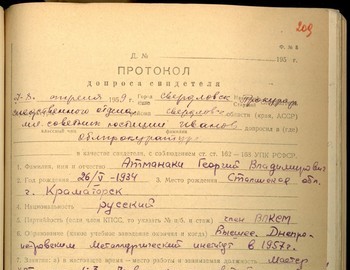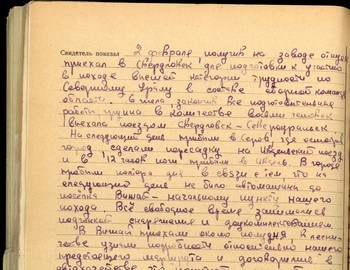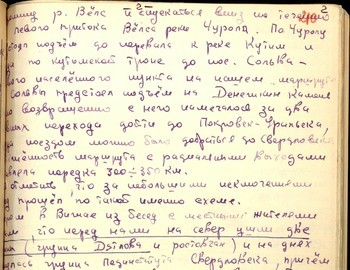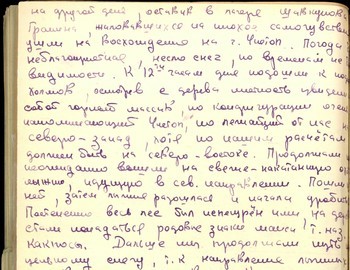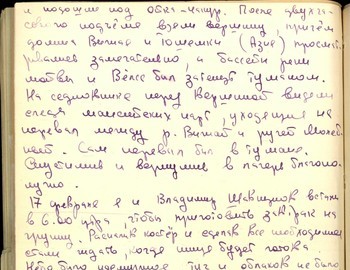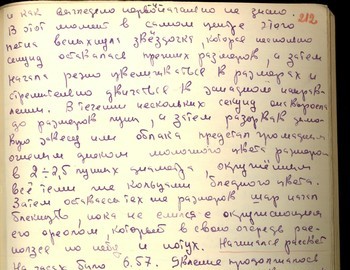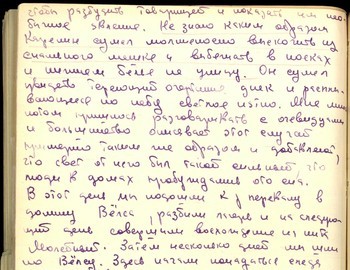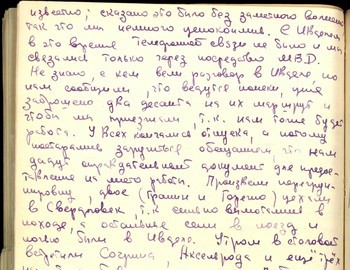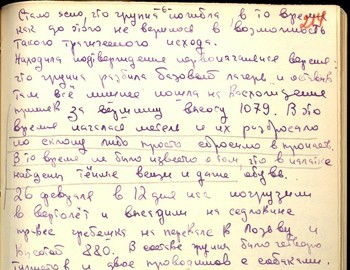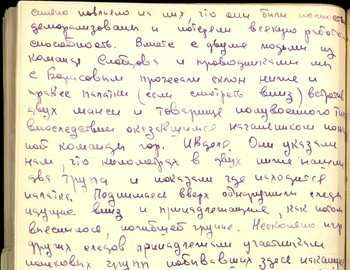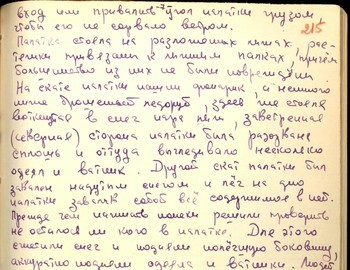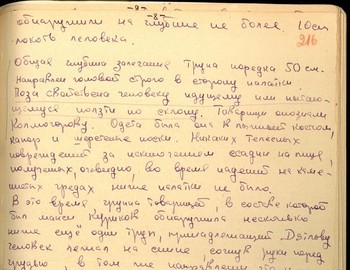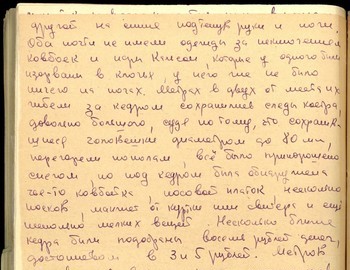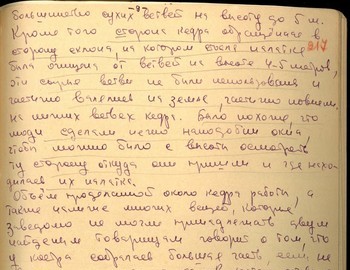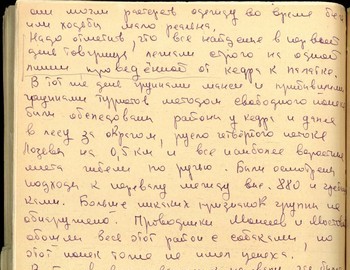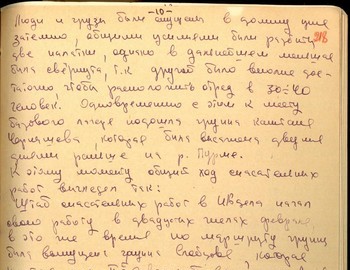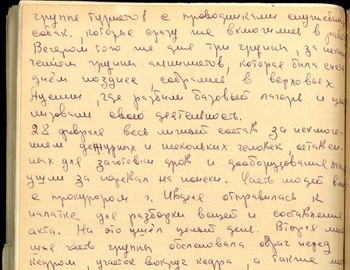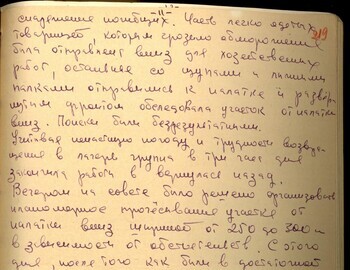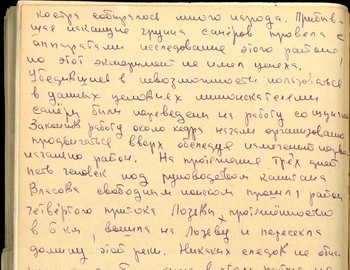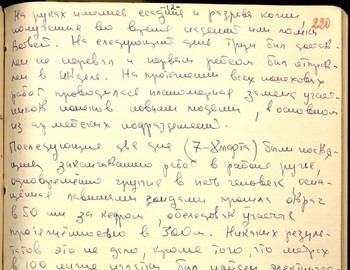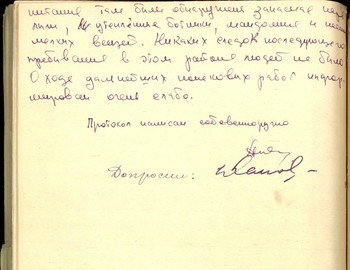
Atmanaki witness testimony
- 1 -
Protocol
witness testimony
April 7-8, 1959 City of Sverdlovsk, Prosecutor of the Investigation Department of the Sverdlovsk region Jr Counselor of Justice Ivanov questioned in the Office of the Prosecutor General as a witness, subject to Art. Art. 162-168 Code of Criminal Procedure of the RSFSR
- Surname, name and middle name: Atmanaki Georgiy Vladimirovich
- Year of birth 26.05.1934
- Place of birth Stalinskiy region city of Kramatorsk
- Nationality Russian.
- Political affiliation: member of the Komsomol
- Education: Higher education from Dnipropetrovsk Metallurgical University in 1957
- Occupation: a) currently - the master of CRP (Cold Rolled Pipe) shop number 3 Pervouralsk Pipe plant.
b) at the moment of the events: the same. - I have no previous conviction.
- Permanent residence: Sverdlovsk region, city of Pervouralsk, Vatutina 21, apt. 18. work 3-56-II phone
- Passport
- Relation to the accused
Warned on the responsibility of the first part of Art. 92 of the RSFSR Criminal Code for refusing to testify and under Art. 95 RSFSR Criminal Code for knowingly giving false testimony.
G. Atmanaki (signature)
Witness testified: on February 2, having received a vacation at the plant, I came to Sverdlovsk to prepare for participation in the hike of the highest category of difficulty in the Northern Urals as part of the regional team. On the 6th day, after completing all the preparatory work, a group of eight people traveled by train Sverdlovsk - Severouralsk. The next day they arrived in Serov, where they examined the city, made a transfer to train going to Ivdel and arrived at Ivdel at 12 o'clock in the morning. The city stayed a day and a half due to the fact that the next day there was no car to the village of Vizhay - the starting point of our hike. All the free time was spent preparing the completing the equipment.
In Vizhay arrived around noon, in the forestry learned details about our upcoming route and agreed in the car park that a passing car we will take us to the village of IInd North, the easiest starting point to go on the route. However, in the evening there was no car and we had to spend the night in the school and start off the next day. At the council, the route and the timetable of the traffic were finally worked out, after which our approach looked like this:
Village of Vizhay - the mouth of North Toshemka river - 83 district - further to the west - northwest on Toshemka river to the mouth of Lohan river from there climbing to Mt Chistop from the base camp on Toshemka river, then in Toschemka with the subsequent transition to the upper reaches of the river. See ascending to the tops of Oyko-Chakur and Peak Molebniy. From the river basin Vizhay was scheduled to pass
- 2 -
into the valley of the river Vyols and descend or downstream to the left tributary of the Vyols river Churola. Along Churola, there was a climb to the pass to the river Kutim and from there along the Kutim trail to the village of Solva which was the first settlement on our route. From Solva there was a rise to Denezhkin Stone, on his return from it it was planned to reach Pokrovsk-Uralsk in two days' travel, from where it was possible to get to Sverdlovsk by train. The length of the route with radial outlets was about 300-350 km.
It should be noted that with few exceptions, the trek preceded along this scheme. In the evening in Vizhay from conversations with local residents we learned that two groups went north in front of us (Dyatlov group and a group from Rostov) and the other day the group of the pedagogical institute of Sverdlovsk returned, and in it there were several people who received frostbite on arms and legs.
The group that went on the route consisted of:
- Atmanaki Georgiy - city of Pervouralsk,
- Borisov Boris - Mining Institute,
- Goryachko Oleg - Mining Institute,
- Granin Victor - city of Giri,
- Karelin Vladislav - Research Institute,
- Serdityh Evgeniy - Pedagogical Institute,
- Skutin Vladimir - Pedagogical Institute,
- Shavkunov Vladimir - Pedagogical Institute.
On the 9th of February in the morning we went to the village of 83rd district, from where it continued along Toshemka river. Two days later the trail approached the mouth of Lohan river where we pitched the base camp and
next day leaving in the camp Shavkunov and Granin, who complained that did not feel well, went to the ascent Mount Chistop. The weather was unfavorable, it was snowing, at times there was no visibility. By 12 o'clock in the afternoon we came to the foot of the hills, having examined the terrain from the trees we observed a mountain, very similar to Chistop, but lying to the north-west, although according to our calculations it should be in the north-east. We continued on our way and unexpectedly came across a freshly trampled hunting track going north. We went along it, then the track parted and began to disappear. Gradually, the whole forest was covered with them, and the native signs of Mansi called Kakpos (Katpos - ed. note). Then we continued entirely on the snow i.e. the direction of the ski tracks did not suit us. When we climbed the foothills the weather deteriorated sharply: a snowstorm started, snow fell, the visibility was completely lost, and we stopped navigating. For the sake of prudence we turned back. At the foot we met Mansi (someone from the Bahtiyarovs' family), the conversation did not turn out, because he almost did not speak Russian, and from us no one was strong in their dialect. We managed to find out that we are standing on the Lohan river, i.e. we did not quite get to Toshemka, and this is why Chistop massif turned out to be in the west. Bahtiyarov's yourt was 20 km to the south of us. We went back and on the way met the family of Bahtiyarov (Alexei Prokopievich, his son and daughter), and there was also a "poor" relative. From them, we have become more articulate about our whereabouts.
- 3 -
Bahtyarov said that from his winter retreat in the direction of Oyko-Chakur leads a trail and that can be traversed in two days with a good pace. At 5 pm we returned to the camp, it was decided to go to the Bahtiyarov yourt the next day and from there go to the top of Oyko-Chakur and Molebniy.
The next day (February 13) it took us several hours to get to Bahtiyarov and we spent the night in his yurt. From the conversations we learned that this winter through his camp passed the groups from the pedagogical institute (Sverdlovsk) to the north to Toshemka, group from Rostov along Vizhay river and there were some vague conversations about a group, which for a long time wandered and returned to where it came from. Bahtiarov refused to take us to the summit, saying that it is a long journey in deep snow, etc., but he promised to show us the beginning of the trail. Accepted us relatively hospitable. The next day the son of Bahtiyarov took us to the trail and went back. Actually there was no trail, there were signs on the trees, marking the trail and untouched snow up to 2 meters deep. There were no traces of man. Two and a half days we continuously crawled along the virgin snow, after which we approached the foot of the ridge, which included the peaks in question. On the next day (February 16) a group of five people (three after a difficult journey stayed in the camp to rest) went to climb up. After passing a small spur
approached Oyko-Chakur. After a two-hour ascent, we went over the summit, and saw Vizhay and Toshemka rivers (Asia) looking wonderful, and the basin of Moyva and Vyols rivers were enclosed with fog. On the saddle before the top we saw the traces of the Mansi sledge going to the pass between Vizhay river and the brook Molebniy. The pass itself was in a fog. We descended and returned to the camp safely.
On February 17, I and Vladimir Shavkunov got up at 6 am to prepare breakfast for the group. After making a fire and preparing everything necessary, we waited for the food to get ready. The sky was gray, there were no clouds, but there was a slight haze, which usually dissipates with the rising of the sun. Sitting facing north and accidentally turning my head to the east, I saw 30° high in the sky a milky white blur about 5-6 moons in diameter and a series of concentric circles. It resembled a halo around the moon in a clear frosty weather. I made a comment to my partner, that's how they painted the moon. He thought and said that in the first there is no moon, and besides, it should be on the other side. From the moment we noticed this phenomenon, it lasted 1-2 minutes, and how long it was there
- 4 -
before we noticed it we don't know. At this moment, at the very center of this spot, an asterisk flared up, which for a few seconds remained the same size, and then began to increase sharply in size and rapidly move in a western direction. Within a few seconds, she grew to the size of the moon, and then tearing off the smoke screen or clouds appeared a huge milk disc of milky color, 2-2.5 moons in diameter, surrounded by the same rings of pale color. Then, remaining the same size, the ball began to fade until it merged with the surrounding halo, which in turn spread out across the sky and went out. It was dawn. The clock was 6.57, the phenomenon lasted no more than a half minutes and produced a very uneasy impression. Initially, we did not pay attention to it, but then, when the glowing disk itself appeared, we were amazed. Personally, I had the impression that some heavenly body was falling in our direction, then, when it had grown to such enormous dimensions, a thought flashed through my head that another planet came into contact with the Earth, that now a collision would follow and nothing would remain of all earthly things. We were already awake for more than an hour, so we were well awake and didn't believe in hallucinations, but we just stood there hypnotized and only when the disc began to fade we rushed to the tent
to wake up our comrades and show them the unusual phenomenon. I do not know how Karelin managed to jump out of the sleeping bag at lightning speed and run outside the tent in his underwear wearing only socks. He managed to see the disc losing its outline and the bright spot spreading across the sky. I had to talk a lot with eyewitnesses, and most people describe this case about the same way and adds that the light from him was so strong that people in homes were awakened from sleep. On this day we went to the pass in the valley of Vyols, camped and the next day made an ascent to Molebniy peak. Then for several days we walked along Vyols. Here we began to come across traces of people, apparently before us was one or several hiking groups with a reindeer team. It was difficult to judge the number of groups and people, because they behaved in a strange way: they did not go as usual in a string, but wandered along the river in disarray, often stopping and leaving for the forest, although it is much more convenient to walk along the river. There is an opinion that while they were passing by the ice, water appeared and they were looking for dry places, and if they were not, they walked around the forest. On Churola, the tracks parted, part went down Vyols, part went along Churola (two ski tracks), then one good track came to the right and they merged into one ski track, though almost completely covered with snow.
- 5 -
We found the camp site of the group, apparently they were heavily exhausted, because it took us a day for two or even three of their day trips. We reached Solva without an incident, there we met a group of hikers from Kazan, going to Konzhakovskiy Stone. From the local residents we learned that through the village passed many different groups, so many that they don't even remember who was from where.
After climbing Denezhkin Stone we reached Pokrovsk-Uralsk, from there by train to Serov, where we had to make a transfer to the Sverdlovsk train. While we were waiting, we went into the dining room, where a comrade came to me, and after presenting himself as member of the Northern Geological Party, he said that in the north, a vigorous search for a group of hikers from the city of Sverdlovsk was undergoing, up to the use of aviation. He asked who we are and whether they are looking for us. I said that we have not yet reached our deadline and asked where is this group from. He could not say anything definite, so we ran to the station and simultaneously ordered a conversation with Sverdlovsk and Ivdel, where we were told the headquarters of the search group. Orlova from Sverdlovsk reported that Dyatlov group was missing, that the deadline was set for February 12 (it was 25) and that so far nothing
has been reported, it was said without any noticeable alarm, so we calmed down a bit. Ivdel did not have a telephone connection at that time and we could get in contact only through the Ministry of Internal Affairs. I do not know who did we speak in Ivdel with, but we were informed that the search was underway, two air drop offs on their route were already landed and that we should join, because there will be work for us. We all ended our holidays, and we tried to secure a promise that they would give us an excuse document for the place of work. We regrouped, two (Granin and Goryachko) left for Sverdlovsk because they were very exhausted from the trek, and the rest got on the train and were in Ivdel that night. In the morning in the dining room we met Sogrin, Akselrod and three other guys who took part in the search. We arrived at the airfield, where Chernyshev group was preparing to dispatch and the plan for Akselrod group in the Otorten area was outlined. Initially, we were supposed to explore the area of the mountain ridge Sapal-Chakhl. I and Skutin flew by plane to Otorten area in order to survey the valley of Lozva and the foothills, and also to plan the sites for the landing in the area. After our return the whole group went to our common apartment to prepare for the departure. In the evening Karelin returned with the news that they had found Dyatlov base camp near Otorten and all the equipment from skis to backpacks was in it.
- 6 -
It became clear that the group was dead, while before that it was not believed that such a tragic outcome is possible. There was confirmation of the original version that the group had made a base camp and leaving there all unnecessary weight went to the ascent the summit of height 1079. At this time a snowstorm began and they were scattered on the slope or simply thrown into the abyss. At that time, it was not known that warm clothes and even shoes were still in the tent. On February 26, at 12 noon, we boarded a helicopter and were dropped off on the saddle to the right of the pass to Lozva and height 880. The group consisted of four hikers and two guides with dogs. Our task was: to split into two groups to find a suitable place for a base camp in the Lozva basin, while another group with dogs would start the survey of the site from the tent and down to Lozva. Leaving skis and equipment on the pass (the second group) I, Borisov, guides Moiseev and Mostovoy walked along the slope towards height 1079, on the pass (the first group) met several people from Slobtsov group who approximately indicated to us the location of the tent of Dyatlov group. The rest of the people of the Slobtsov group were at the ridge on the pass, and later it became apparent that finding the tent and the dead bodies of their friends
affected them so badly, that they were completely demoralized and unable to continue working. Together with two people from Slobtsov team and the guides, Borisov and I combed the slope lower and to the right of the tent (if we look down) meeting on the way two Mansi and a comrade of a paramilitary type, who later turned out to be the chief of the Ivdel fire brigade. They told us that they found two bodies 2 km down and showed us where the tent is located. Going up we observed traces that were going down and belonging, as it later turned out, to the dead hikers. Several pairs of other tracks belonged to the participants of the search parties who were working the day before. There were no other tracks or objects on this site, except for a roll of film about 15 m below the tent, which rolled out from there during the preliminary inspection of the tent the day before. All remained undisturbed except for one backpack in which small things were gathered around the tent. They did not make a detailed inspection of the tent, because they explained that they were afraid to see their comrades in it. The tent stood sideways to the slope by the entrance to the east, the entrance was unbuttoned but piled in half with buckets, stove and backpacks, so that at first there was an impression that people tried to barricade
- 7 -
the entrance by stacking the corner of the tent with a load so that it will not be torn by the wind. The tent was laid on skis, straps were tied to ski poles, and most of them were not damaged. On the slope of the tent we found a flashlight, an ice ax not far away down, there was a pair of skis stuck in the snow, the windy (north) side of the tent was torn and some blankets and a quilted jacket were protruding out. The other side of the tent was heaped with bulging snow and lay on the bottom of the tent, overlaying all the contents in it. Before we started the search we decided to check if there was anyone left in the tent. Snow was removed, the fallen side of the tent was raised, and we carefully removed the blankets and quilted jackets. There were no people in the tent. Inspected the contents. The bottom of the tent lay on skis, then quilted jackets, backpacks, gaiters and other small equipment. Towards the heads on the south side were felt boots and boots, in the far right corner we found a field bag with the documents of the group, a box of films and money, a camera and a few small objects, everything was packed in a backpack, except for the diary and documents sent to the base camp. There was no point to continue the further dismantling of the things, and so they left everything into place before the investigator arrived, after raising the tent and pulling out three pairs of
skis, because dog guides went on foot, and the rest of the skis were used by us to mark the places where the bodies of the dead were found. There were no traces around the tent, because digging around the tent we threw a lot of snow, which was subsequently carried away by the wind, destroying all traces. Abandoned flashlight and traces of urine at the tent suggested that someone had gone outside at night, was stormed by the wind and carried away and that the others, hurrying to help, were also charged down the mountain by the bad weather. However, later going up to the place where the tent stood we were convinced that with any wind you can stay on the slope and go back. 20-30 m below the tent in Lozva valley led a string of tracks well preserved till this time, at first the tracks were in two groups, then joined together and were visible for 700-800 m, after which they disappeared under the fresh snow. After the inspection of the tent we went down, indicating to the Slobtsov group the supposed place for the base camp and instructing them to go there and carry the equipment. After passing several rocky ridges, crossing the slope across, we descended into the valley continuing to follow the trail. This site was surveyed the day before by the Mansi group and this survey did not yield any results. In the hollow on a completely flat not trampled snow, Moiseev's dog displayed anxiety. We dug off the snow
- 8 -
and found human elbow at a depth of no more than 10 cm. The total depth of the body is about 50 cm. The head is directed strictly toward the tent. The pose is peculiar to the person walking or trying to crawl up the slope. The comrades identified Kolmogorova. She was dressed in a ski suit, a hood and woolen socks. There were no physical injuries, except for abrasions on the face, obtained, obviously, during the falls on the stony ridges below the tent. At the same time, a group of comrades, including Mansi Kurikov had discovered a further down another body belonging to Dyatlov. He was lying on his back, his arms bent in front of his chest, in the same direction as Kolmogorova. He wore a ski suit, fur sleeveless vest and woolen socks. The impression was that the person was also trying to go up, judging by the position of the body and also the fact that he had his head in a group of small trees, where he obviously rested, but to get there if he was coming form top he would have to bypass and come back up to get to the place where his body was found. Finally, about 1.5 km from the tent under the cedar, the bodies of Krivonischenko and Doroshenko were found (earlier that day), lying side by side on a thin layer of fir branches. One of them lay buried face down with his hands clasped under his head.
The other on his back with his arms and legs stretched up. Both had almost no clothes except for the checkered shirts and a pair of pants that one had torn to shreds, and he had nothing on his legs. Meters in two from the place of their death for the cedar have left traces of a fire, quite large, judging by the fact that the remaining logs with a diameter of up to 80 mm, burned in half, everything was powdered with snow, but under the cedar were found someone's checkered shirt, a handkerchief, several socks, cuffs from a jacket or sweater and a few more small things. Closer to the cedar were found eight rubles of money, in two bills of 3 and 5. Twenty meters around the cedar were left traces of how one of those present at the cedar cut young fir trees with a knife, we saw about twenty such cuts, but we didn't find the cut branches except one. It is not very likely that they have been used for heating, because in the first place, they don't burn well, and besides there was relatively lots of dry materials around them. In addition, there was no need to cut or chop, because all these young shoots easily broke even from a small effort. One might think that people who did this were very weak, or with a clouded mind. On the cedar, there are traces of fresh kinks.
- 9 -
Most dry branches up to 5 m high were broken. In addition, the side of the cedar facing the slope on which the tent stood was cleared of branches at an altitude of 4-5 m. These raw branches were not used and partially fell on the ground, partially suspended on the lower branches of the cedar. It looked like people had done something like a window, so they could look from the top of that side of the cedar where they came from and where their tent was.
The amount of work done around the cedar, as well as the presence of many things that obviously could not belong to the two comrades found, indicates that the fire had gathered most, if not the whole group, and after making a fire left some of the people there, part decided to go back, to dig up the tent and bring warm clothes and equipment, and the remaining comrades engaged in making something like a hole where the harvested fir branches was used to wait out the weather and wait for the dawn. It is unclear why Krivonischenko and Doroshenko were stripped, for in winter hikes, even more in condition of cold overnight, it is not customary to undress to such an extent. It is possible that the misfortune occurred either when they were changing clothes (evening or morning),
or they were undressed later, because the version that they could lose clothes during running or walking is not very probable.
It should be noted that all the comrades found on the first day lay strictly on one line, drawn from the cedar to the tent. On the same day, Mansi and the arriving groups of hikers by the method of free search examined the areas near the cedar and even in the forest beyond the ravine, the bed of the fourth Lozva tributary at a distance of 0.5 km and all the most probable places of death along the stream. Approaches to the pass between the height 880 and the ridge were examined. No more signs of the group were found. The guides Moiseev and Mostovoy went around the whole area with the dogs, but this search was also not successful. At 5 pm we went to the pass, where equipment was stacked, we learned that the camp was planned to be pitched not in Lozva valley, but in the upper part of Auspiya, in favor of this variant a whole series of arguments was cited, the most convincing of which was the attempt not to make on Lozva unnecessary traces to interfere with the search with the dogs.
Time showed that this decision greatly increased the time required for approaches and retreat from the search site, much greater effort was required and especially complicated work during the period of the thaw when the slopes of the pass were covered with ice crust.
- 10 -
The people and cargo were lowered into the valley after dark, two tents were pitched up with common efforts, but in the future the smaller one was pared down, because the other was quite enough to accommodate a detachment of 30-40 people. At the same time, the group of Captain Chernyshev, who had been landed two days earlier on Purma river arrived at the base camp.
By this time, the overall course of rescue operations was as follows:
The rescue headquarters in Ivdel began its work around February 20, at the same time Slobtsov group landed on the route of the group, passed II North and reached Lozva without finding any traces followed the third tributary to Lozva river and on the slope of height 1079 found Dyatlov group tent, they also found traces of the group leading to the pass in the valley of Auspiya. On February 26, at 12 pm, a group of operational officers of Captain Chernyshev was sent to Purma, while a group of climbers landed at the summit of Otorten, whose mission was to comb the slopes of Otorten and survey the valley on the south-western spur of the summit.
February 27 in the morning was sent
group of hikers and guides with search dogs, who immediately joined in the work. In the evening of the same day, three groups, with the exception of the group of climbers, who was sent a day later, gathered in the upper reaches of Auspiya, where they built base camp and centralized their efforts.
On February 28 all the personnel, except for the people on duty and a few people left for the preparation of firewood and additional equipment for the camp, went over the pass to search. Part of the people together with the Ivdel prosecutor went to the tent to disassemble things and draw up a protocol. This took a whole day. The second smaller part of the group surveyed the ravine in front of the cedar, the site around the cedar, and the places where the dead comrades had been found the day before. The guides worked with the dogs. No new results were found in the search. A group of five people took three bodies to the pass for transportation to Ivdel. Belongings to the dead group were taken to the pass and prepared for shipment. In the evening, during communication with Ivdel, avalanche probes, necessary products and materials were ordered. The next day, in very bad weather (cold, wind and lack of visibility), the group went to the pass, a helicopter arrived and the belongings and
- 11 -
equipment of the deceased were sent. Some of the lightly dressed comrades who could get frostbite were sent down for chores, the rest with probes and ski poles went to the tent and with an open front surveyed the site from the tent down. The search was unsuccessful. Taking into account the inclement weather and the difficult way back to the camp, at 3 pm the group finished the work and returned back.
In the evening on the council it was decided to organize systematic sweeping of the site from the tent down to a width of 250 to 300 m depending on the circumstances. From that day, after they were adequately equipped with probes and other tools, the group began to move down and probing, and in dubious places plowing snow. At the same time, a group of five people launched a search down the cedar area. An area of 50 m behind the cedar was probed, the ravine leading there was not examined due to the fact that the probes that were available did not allow us to check the entire depth of the snow, reaching 4-5 m in places. The area adjoining directly to the fire was dug up; a layer of well trampled melted snow was found around the fire, which indicates that
there were a lot of people gathered around the fire. The group of sappers who had arrived the day before had conducted a survey of the area, but the experiment was not successful. Convinced of the inability to use mine detectors under these conditions, sappers were transported to work with probes. Having finished search near the cedar they began to move upward in an orderly way, surveying the originally planned area. Over the course of three days, five people, led by Captain Vlasov, freely searched the area of the fourth tributary of Lozva, a length of 6 km, went to Lozva and crossed the valley of the river. No traces were found, the depth of snow in this region is not less than 1.5-2 m, so that the group's withdrawal in this direction is not possible, in the following days sections along the slope of height 1079 were searched and further to the north, and also completed a roundabout along the slope of height 880 with a subsequent descent to the tributary of Lozva; traces are not present, to go further without skis is practically impossible.
Meanwhile, the main group discovered Slobodin's body about 1000 m from the tent, wearing ski suit, hat, warm socks and one felt boot. The body was positioned with his head toward the tent, as if he crawled or walked up the slope.
- 12 -
On his hands he has abrasions and cuts of the skin, obtained during falls or breaking branches. The next day the body was taken to the pass and sent to Ivdel on the first flight. Throughout the search operation, systematic replacement of the participants by new people was carried out, mainly from the army units.
The next two days (March 7-8) were dedicated to the completion of work in the creek area, simultaneously a group of five people equipped with avalanche probes searched 50 m of the ravine behind the cedar, surveying 300 m long section. No results yielded, except that 100 m below the tent an electric flashlight was found switched on and out of battery belonging to someone from the dead group.
On March 8, the head of the search group Maslennikov flew to Ivdel to discuss further search activities.
On March 9, I was retracted from the camp because I had to go back to work in the factory. On one of the last days of our group trip to search the upper reaches of Auspiya, 400 m from the search base camp, was found Dyatlov group cache site, made before going to the pass and height 1079.
In addition to food, there was a spare pair of skis, warm boots, mandolin and a few small things. There were no other signs of people being in the area. I am very poorly informed on the progress of the further search operation.
The protocol is written by me personally
G. Atmanaki (signature)
Interrogator L. Ivanov (signature)

